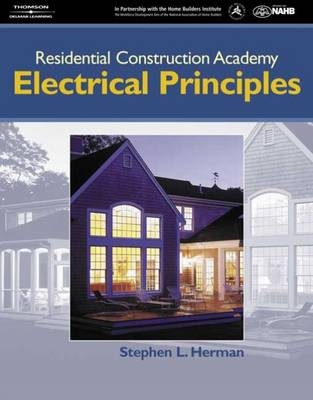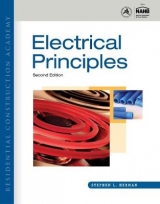
Residential Construction Academy: Electrical Principles
Delmar Cengage Learning (Verlag)
978-1-4018-1294-2 (ISBN)
- Titel erscheint in neuer Auflage
- Artikel merken
Create a direct link between your education/training program and the residential construction industry! Training materials are now available for many of the residential crafts based on skill standards developed by the nation's leading builders and educators. The result of a strategic partnership between the National Association of Home Builder's Home Builders Institute and Delmar Learning, the Residential Construction Academy Series is the perfect way to teach essential workplace skills to people new to the building trades.
Ideal for use in vocational programs, workforce development programs, professional associations, and trade unions, all materials are based on industry standards. The Residential Construction Academy also offers credentialing for programs using the skill standards and materials, along with a national registry of students who have successfully completed participating programs. The goal is a workforce that is skilled, knowledgeable, and able to meet the needs of the industry today and well into the future.
As a retired electrician and proficient instructor with more than 30 years of practical experience, Stephen L. Herman is known for his reader-friendly approach. A seasoned author, Mr. Herman has written leading books on electricity and mathematics that are popular with students and instructors alike. For two decades Mr. Herman served as lead instructor for the Electrical Technology Curriculum at Lee College in Baytown, Texas, where he received an Excellence in Education Award from the Halliburton Education Foundation. He also taught at Randolph Community College in Asheboro, North Carolina, for nine years and helped pioneer an electrical curriculum for Northeast Texas Community College in Mount Pleasant, Texas. His additional publications include ELECTRIC MOTOR CONTROL, ELECTRICITY AND CONTROLS FOR HVAC/R, INDUSTRIAL MOTOR CONTROLS, UNDERSTANDING MOTOR CONTROLS, ELECTRONICS FOR ELECTRICIANS, ALTERNATING CURRENT FUNDAMENTALS, DIRECT CURRENT FUNDAMENTALS, ELECTRICAL STUDIES FOR TRADES, ELECTRICAL PRINCIPLES, EXPERIMENTS IN ELECTRICITY FOR USE WITH LAB VOLT EQUIPMENT, THE COMPLETE LABORATORY MANUAL FOR ELECTRICITY, and PRACTICAL PROBLEMS IN MATHEMATICS FOR ELECTRICIANS.
Section OneBasic Electricity1
Chapter 1 Safety3
General Safety Rules5
Effects of Electric Current on the Body5
Protective Clothing8
Ladders and Scaffolds9
Fires11
Ground Fault Circuit Interrupters12
Grounding 13
Summary14
Review Questions 14
Chapter 2Basic Electrical Theory19
Early History of Electricity21
Atoms21
The Law of Charges23
Centrifugal Force24
Electron Orbits24
Valence Electrons25
Electron Flow26
Insulators26
Methods of Producing Electricity26
Summary 27
Review Questions27
Chapter 3Electrical Quantities and Ohms Law28
The Coulomb30
The Amp30
The Electron Theory30
The Conventional Current Theory30
Speed of Current 31
Basic Electrical Circuits32
The Volt33
The Ohm33
The Watt34
Other Measures of Power35
Ohms Law36
Metric Units39
Summary39
Review Questions40
Chapter 4Resistors41
Uses of Resistors43
Fixed Resistors43
Color Code45
Standard Resistance Values of Fixed Resistors48
Power Ratings49
Variable Resistors50
Schematic Symbols51
Summary52
Chapter 5Series Circuits54
Series Circuits56
Voltage Drops in a Series Circuit56
Resistance in a Series Circuit57
Calculating Series Circuit Values57
Solving Circuits58
Voltage Dividers64
The General Voltage Divider Formula65
Voltage Polarity65
Using Ground as a Reference66
Summary67
Review Questions67
Chapter 6Parallel Circuits69
Parallel Circuit Values71
Parallel Resistance Formulas72
Summary 79
Review Questions80
Chapter 7Combination Circuits82
Combination Circuits84
Solving Combination Circuits84
Simplifying the Circuit84
Summary96
Review Questions96
Chapter 8Measuring Instruments99
Analog Meters101
The Voltmeter101
Multirange Voltmeters102
Reading a Meter103
The Ammeter105
Ammeter Shunts105
AC Ammeters106
Clamp-on Ammeters108
DC-AC Clamp-on Ammeters108
The Ohmmeter110
Digital Meters111
The Low-Impedance Voltage Tester113
Summary114
Review Questions115
Chapter 9Using Wire Tables and Determining Conductor Sizes 116
Using the National Electric Code Charts118
Factors That Determine Ampacity118
Correction Factors122
Computing Conductor Sizes and Resistance123
Computing Voltage Drop128
Parallel Conductors128
Testing Wire Installations129
Summary130
Review Questions131
Section TwoAlternating Current145
Chapter 10 Magnetic Induction132
Magnetic Induction134
Flemings Left-Hand Generator Rule135
Moving Magnetic Fields135
Determining the Amount of Induced Voltage135
Lenzs Law136
Rise Time of Current in an Inductor136
The Exponential Curve137
Inductance138
R-L Time Constants139
Induced Voltage Spikes140
Summary142
Review Questions143
Chapter 11Alternating Current147
Advantages of Alternating Current149
AC Wave Forms149
Sine Wave Values151
Resistive Loads155
Power in an AC Circuit155
Skin Effects in AC Circuits155
Summary156
Review Questions157
Chapter 12Inductance in Alternating Current Schedules159
Inductance161
Inductive Reactance162
Schematic Symbols164
Inductors Connected in Series164
Inductors Connected in Parallel165
Voltage and Current Relationships in an Inductive Current166
Power in an Inductive Circuit166
Reactive Power167
Q of an Inductor167
Summary168
Review Questions169
Chapter 13Resistance-Inductive Series Circuits170
RL Series Circuits172
Impedance172
Vectors172
Total Current 176
Voltage Drop across the Resistor176
Watts176
Computing Inductance177
Voltage Drop across the Inductor177
Total Voltage177
Computing the Reactive Power178
Computing the Apparent Power178
Power Factor178
Angle Theta179
Summary184
Review Questions184
Chapter 14Resistive-Inductive Parallel Circuits186
Resistive-Inductive Parallel Circuits188
Computing Circuit Values188
Summary195
Review Questions195
Chapter 15Capacitors197
Capacitors199
Electrostatic Charge200
Dielectric Constants201
Capacitor Ratings202
Capacitors Connected in Parallel202
Capacitors Connected in a Series203
Capacitive Charge and Discharge Rates203
RC Time Constants204
Applications for Capacitors205
Nonpolarized Capacitors205
Polarized Capacitors207
Variable Capacitors208
Testing Capacitors208
Connecting the Capacitor into an AC Circuit209
Capacitive Reactance210
Voltage and Current Relationships in a Pure Capacitive Circuit211
Power in a Pure Capacitive Circuit212
Capacitor Voltage Rating212
Effects of Frequency in a Capacitive Circuit213
Summary218
Review Questions 219
Chapter 16Single-Phase Transformers221
Single-Phase Transformers223
Isolation Transformers223
Autotransformers233
Transformer Polarities235
Voltage and Current Relationships in a Transformer237
Testing the Transformer 238
Transformer Ratings239
Determining Maximum Current239
Transformer Impedance239
Summary240
Review Questions241
Chapter 17Single-Phases Motors243
Split-Phase Motors245
Resistance-Start Induction-Run Motors246
Capacitor-Start Induction-Run Motors250
Dual-Voltage Split-Phase Motors251
Determining the Direction of Rotation for Split-Phase Motors252
Capacitor-Start Capacitor-Run Motors252
Shaded-Pole Induction Motors254
Multispeed Motors255
Single-Phase Synchronous Motors256
Warren Motors256
Universal Motors257
Summary259
Review Questions260
Appendix ATrigonometric Functions-Natural Sines and Cosines261
Appendix BTrigonometric Functions-Natural Tangents and Cotangents263
Appendix CAlternating Current Formulas265
Appendix D Greek Alphabet270
Appendix EScientific Notation271
Appendix FAnswers to Practice Problems273
Index
| Verlagsort | Clifton Park |
|---|---|
| Sprache | englisch |
| Maße | 223 x 282 mm |
| Gewicht | 863 g |
| Themenwelt | Sozialwissenschaften ► Pädagogik |
| Technik | |
| ISBN-10 | 1-4018-1294-5 / 1401812945 |
| ISBN-13 | 978-1-4018-1294-2 / 9781401812942 |
| Zustand | Neuware |
| Haben Sie eine Frage zum Produkt? |
aus dem Bereich



